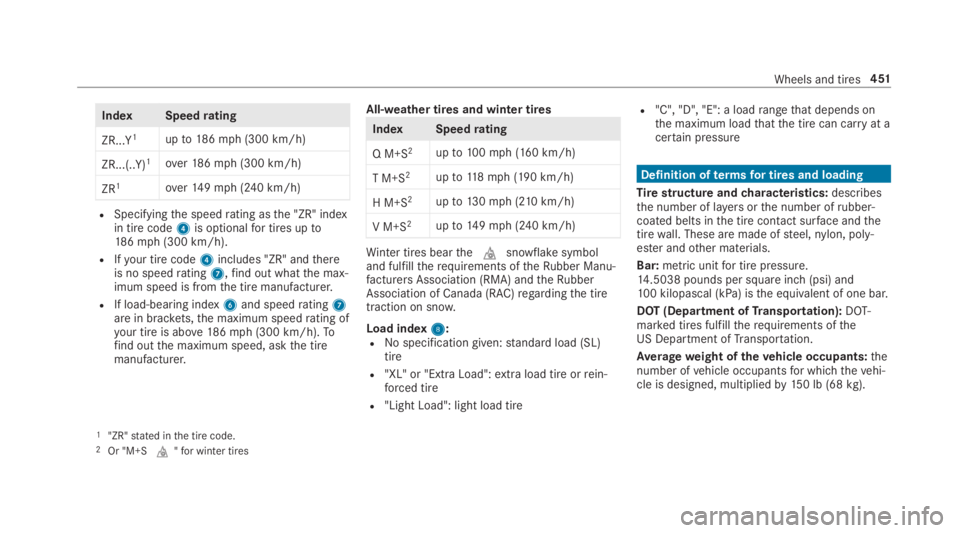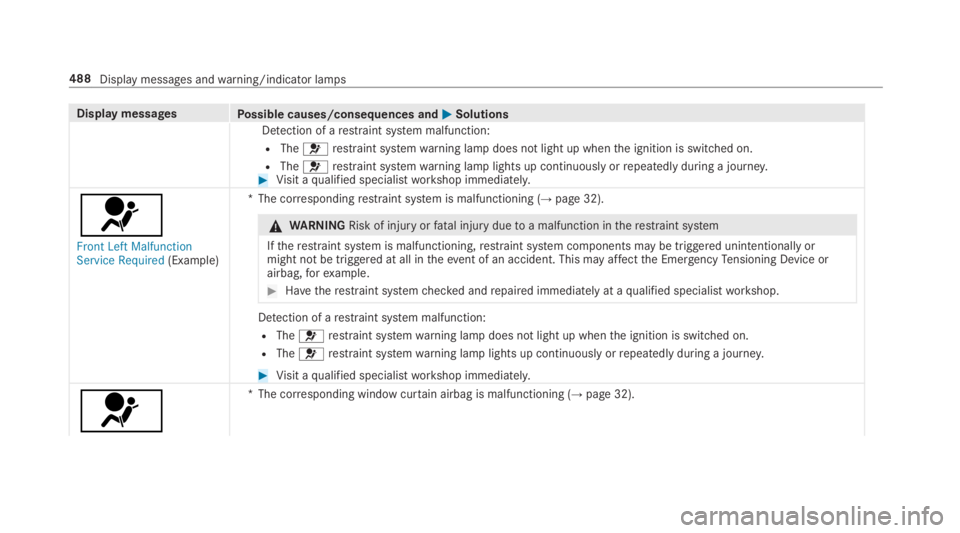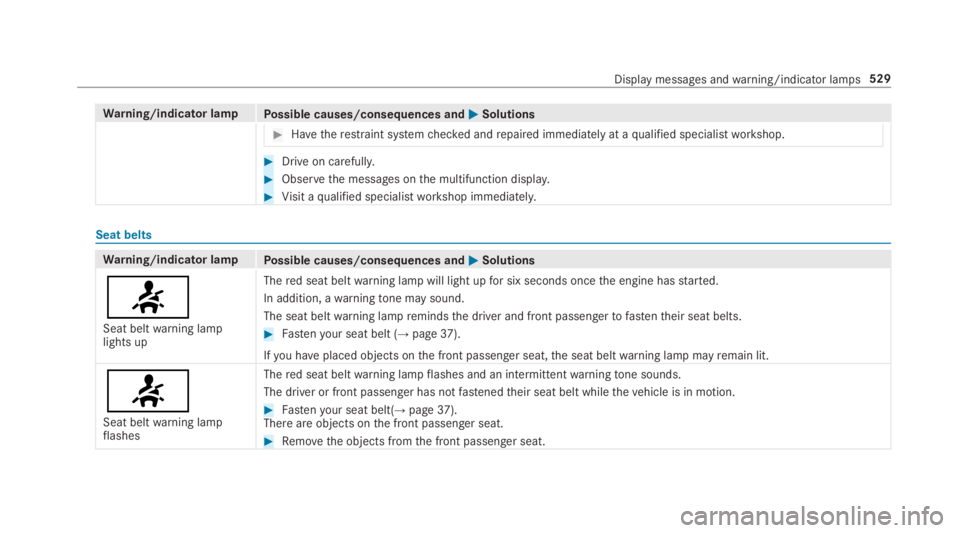Page 453 of 578

IndexSpeedrating
ZR...Y1upto186mph (300 km/h)
ZR...(..Y)1over186mph (300 km/h)
ZR1over149mph (240 km/h)
RSpecifyingthe speedrating asthe "ZR" indexin tire code4is optionalfor tires upto186mph (300 km/h).
RIfyour tire code4includes "ZR" andthereis no speedrating7,find out whatthe max‐imum speed is fromthe tire manufacturer.
RIf load-bearing index6and speedrating7are in brackets,the maximum speedrating ofyour tire is above186mph (300 km/h).Tofind outthe maximum speed, askthe tiremanufacturer.
All-weather tires and winter tires
IndexSpeedrating
Q M+S2upto100mph (160 km/h)
T M+S2upto118mph (190 km/h)
H M+S2upto130mph (210km/h)
V M+S2upto149mph (240 km/h)
Winter tires bearthe�Msnowflake symboland fulfilltherequirements oftheRubber Manu‐facturers Association (RMA) andtheRubberAssociation of Canada (RAC)regardingthe tiretraction on snow.
Load index88:RNo specification given:standard load (SL)tire
R"XL" or "Extra Load":extra load tire orrein‐forced tire
R"Light Load": light load tire
R"C", "D", "E": a loadrangethat depends onthe maximum loadthatthe tire can carryat acertain pressure
Definition oftermsfor tires and loading
Tirestructureandcharacteristics:describesthe number of layersorthe number ofrubber-coated belts inthe tire contact surface andthetirewall. These are made ofsteel,nylon, poly‐ester andother materials.
Bar:metric unitfor tire pressure.14.5038 pounds per square inch (psi) and100 kilopascal (kPa) isthe equivalent of one bar.
DOT (Department ofTransportation):DOT-marked tires fulfilltherequirements oftheUS Department ofTransportation.
Averageweight ofthevehicle occupants:thenumber ofvehicle occupantsfor which thevehi‐cle is designed, multipliedby150 lb (68kg).
1"ZR"stated inthe tire code.2Or "M+S�M"for winter tires
Wheels and tires451
Page 455 of 578

these are installed onthevehicle, but does notinclude passengers or luggage.
Maximum tire load:the maximum tire load isthe maximum permissibleweight in kilograms orlbsfor whicha tire is approved.
Maximum permissible tire pressure:maxi‐mum permissible tire pressurefor one tire.
Maximum load on one tire:maximum load onone tire. This is calculatedbydividingthe maxi‐mum axle load of one axlebytwo.
PSI (pounds per square inch):standard unit ofmeasurementfor tire pressure.
Aspectratio:ratio between tire height and tirewidth in percent.
Tirepressure:pressure insidethe tire applyingan outwardforcetoeverysquare inch ofthe tire.The tire pressure is specified in pounds persquare inch (psi), in kilopascals (kPa) or in bar.The tire pressure should only be corrected whenthe tires are cold.
Cold tire pressure:the tires are cold whenthevehicle has been parkedfor at least3 hours
without direct sunlight onthe tires orthevehiclehas been drivenfor lessthan 1 mile (1.6 km).
Tirecontact surface:the part ofthe tirethatcomes into contact with theroad.
Tirebead:the purpose ofthe tire bead istoensurethatthe tire sits securely onthe wheelrim. There are several wire cores inthe tire beadtopreventthe tire fromchanging length onthewheelrim.
Sidewall:the part ofthe tire betweenthe treadandthe tire bead.
Weight of optional equipment:the combinedweight ofthe optional equipmentweighing morethanthereplacedstandard parts and morethan5 lbs (2.3kg).This optional equipment, such ashigh-performance brakes, level control system, aroof luggagerackor high-performance batteries,is not included inthe curbweight andtheweightofthe accessories.
TIN (Tire IdentificationNumber):a uniqueidentification number which can be usedby atire manufacturertoidentify tires,forexample,in a productrecall, andthus identifythe pur‐chasers. The TIN is made up ofthe manufactur‐
er's identity code, tire size, tire type code andthe manufacturing date.
Load-bearing index:the load-bearing index is acodethat containsthe maximum load-bearingcapacity of a tire.
Traction:traction isthe gripresulting from fric‐tion betweenthe tires andtheroad surface.
Wear indicator:narrowbars (treadwear bars)that are distributedoverthe tire contact surface.Ifthe tire tread is level withthe bars,thewearlimit of 1/16in (1.6 mm) has beenreached.
Distribution ofvehicle occupants:distributionofvehicle occupantsover designated seat posi‐tions in avehicle.
Maximum permissible payloadweight:nomi‐nal load and luggage load plus150 lb (68kg)multipliedbythe number of seats inthevehicle.
Wheels and tires453
Page 488 of 578
Display messagesPossible causes/consequences and�P�PSolutions
#HaveABS and ESP®checked immediately at aqualified specialistworkshop.
#Carefully drive on a suitablestretch ofroad, making slightsteering movements at a speed above19mph(30 km/h).
#Ifthe display message does not disappear, consult aqualified specialistworkshop immediately. Drive carefully.
�%
�
Page 490 of 578

Display messagesPossible causes/consequences and�P�PSolutions
Detection of arestraint system malfunction:
RThe�urestraint systemwarning lamp does not light up whenthe ignition is switched on.
RThe�urestraint systemwarning lamp lights up continuously orrepeatedly during a journey.#Visit aqualified specialistworkshop immediately.
�u
Front Left MalfunctionService Required(Example)
*The correspondingrestraint system is malfunctioning (→page 32).
&WARNINGRisk of injuryorfatal injury duetoa malfunction intherestraint system
Iftherestraint system is malfunctioning,restraint system components may be triggered unintentionally ormight not be triggered at all intheevent of an accident. This may affectthe EmergencyTensioning Device orairbag,forexample.
#Havetherestraint systemchecked andrepaired immediately at aqualified specialistworkshop.
Detection of arestraint system malfunction:
RThe�urestraint systemwarning lamp does not light up whenthe ignition is switched on.
RThe�urestraint systemwarning lamp lights up continuously orrepeatedly during a journey.
#Visit aqualified specialistworkshop immediately.
�u
*The corresponding window curtain airbag is malfunctioning (→page 32).
488Display messages andwarning/indicator lamps
Page 522 of 578
Display messagesPossible causes/consequences and�P�PSolutions
#Openthe windowtoensurethatthere is an adequate supply of fresh air.
#Visit aqualified specialistworkshop immediately.
Lights
Display messagesPossible causes/consequences and�P�PSolutions
�I
Intell. Light System Inoper-ative
*The Intelligent Light System is defective. The lighting system continuestofunction properly withoutthe functions ofthe Intelligent Light System.
#Visit aqualified specialistworkshop.
�I
Check Left LowBeam(Example)
*The corresponding light source is defective.
#Drive on carefully.
#Visit aqualified specialistworkshop immediately.
%LED light bulbs:the display messageforthe corresponding lamp appearsonly when allthe light-emitting diodesinthe lamp havefailed.
�I
*The active headlamps are defective.
#Visit aqualified specialistworkshop.
520Display messages andwarning/indicator lamps
Page 523 of 578
Display messagesPossible causes/consequences and�P�PSolutions
Active Headlamps Inopera-tive
�I
Switch Off Lights
*You are leavingthevehicle andthe lights arestill switched on.
#Turnthe light switchtothe�Xposition.
�I
Malfunction See Opera-tor’s Manual
*Theexterior lighting is defective.
#Visit aqualified specialistworkshop.
�I
Switch On Headlamps
*You are driving without low-beam headlamps.
#Turnthe light switchtothe�Xor�Xposition.
�I
Automatic Headlamp ModeInoperative
*The light sensor isfaulty.
#Consult aqualified specialistworkshop.
Display messages andwarning/indicator lamps521
Page 525 of 578
Warning and indicator lamps
Overview ofwarning and indicator lamps
Some systems will performa self-test whentheignition is switched on. Somewarning and indi‐cator lamps may brieflylight up orflash. Thisbehavior is non-critical. Thesewarning and indi‐cator lamps indicate a malfunction only iftheylight up orflash afterthe engine has beenstar‐ted or during a journey.
Instrument Display
Progressive setting
Ifyou selectthe progressive display setting,thepositions ofthe indicator lamps onthe instru‐ment display willchange.
Warning and indicator lamps:�XLow beam(→page145)
�`Parking lights (→page145)
�WHigh beam(→page146)
�>�=Turnsignal lights(→page146)
�^Rearfog light(→page145)
�uRestraint system(→page 524)
�
Page 531 of 578

Warning/indicator lampPossible causes/consequences and�P�PSolutions
#Havetherestraint systemchecked andrepaired immediately at aqualified specialistworkshop.
#Drive on carefully.
#Observethe messages onthe multifunction display.
#Visit aqualified specialistworkshop immediately.
Seat belts
Warning/indicator lampPossible causes/consequences and�P�PSolutions
�v
Seat beltwarning lamplights up
Thered seat beltwarning lamp will light upfor six seconds oncethe engine hasstarted.
In addition, awarningtone may sound.
The seat beltwarning lampremindsthe driver and front passengertofastentheir seat belts.
#Fastenyour seat belt (→page37).
Ifyou haveplaced objects onthe front passenger seat,the seat beltwarning lamp mayremain lit.
�v
Seat beltwarning lampflashes
Thered seat beltwarning lampflashes and an intermittentwarningtone sounds.
The driver or front passenger has notfastenedtheir seat belt whilethevehicle is in motion.
#Fastenyour seat belt(→page37).There are objects onthe front passenger seat.
#Removethe objects fromthe front passenger seat.
Display messages andwarning/indicator lamps529